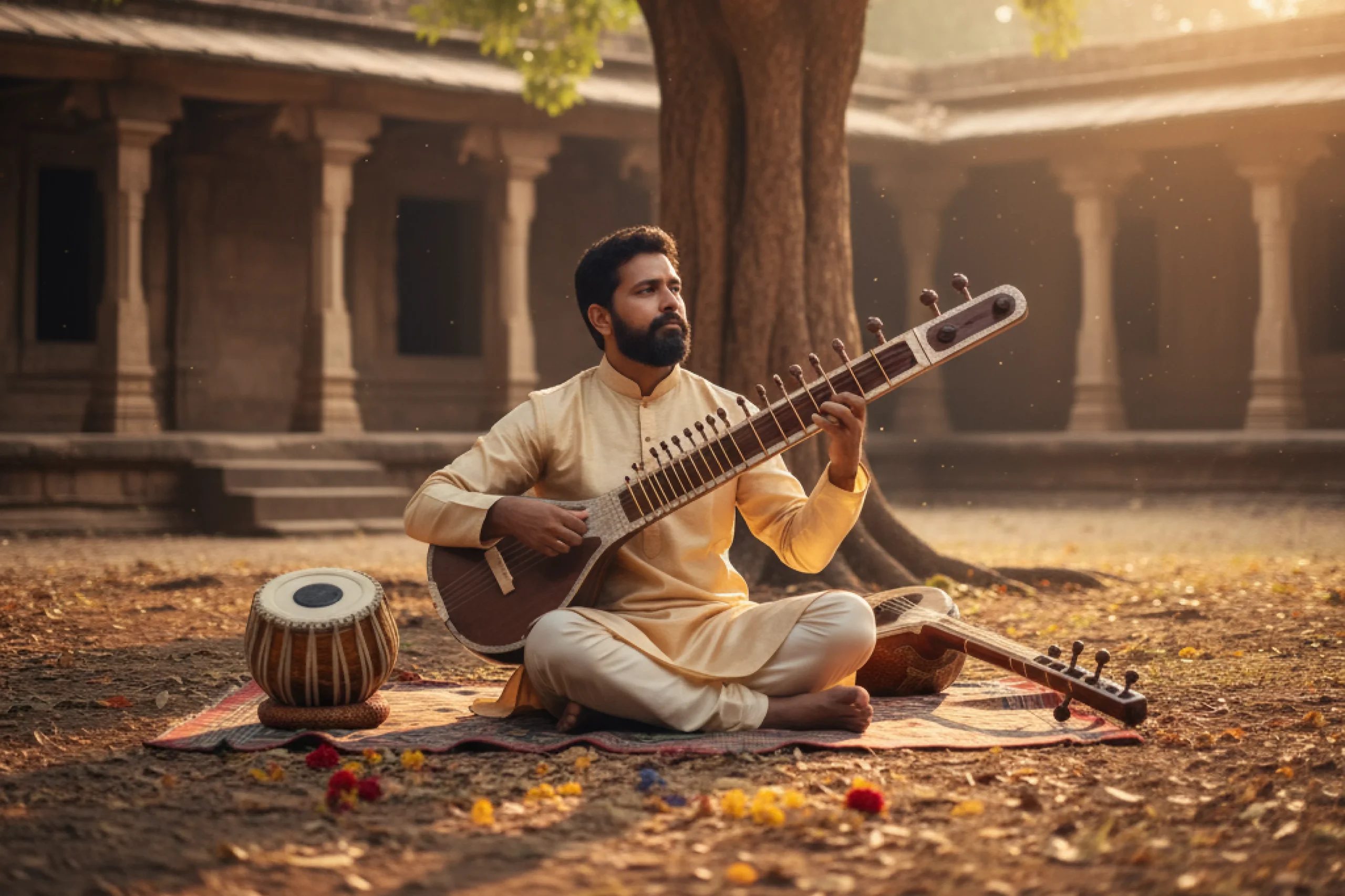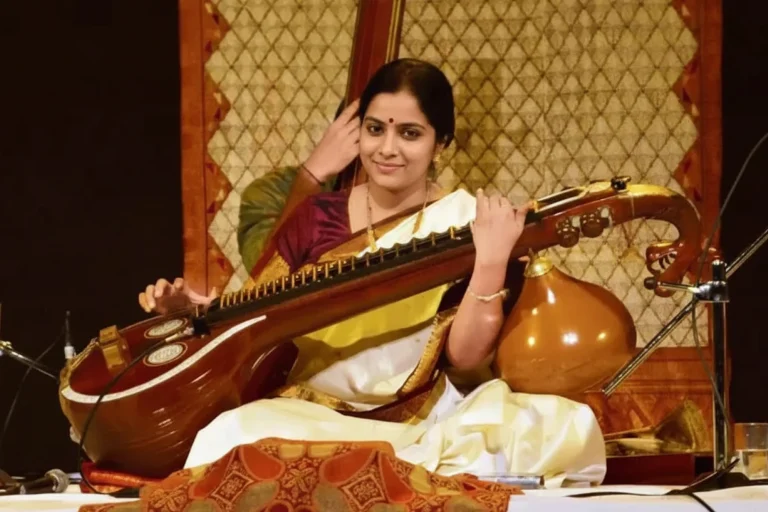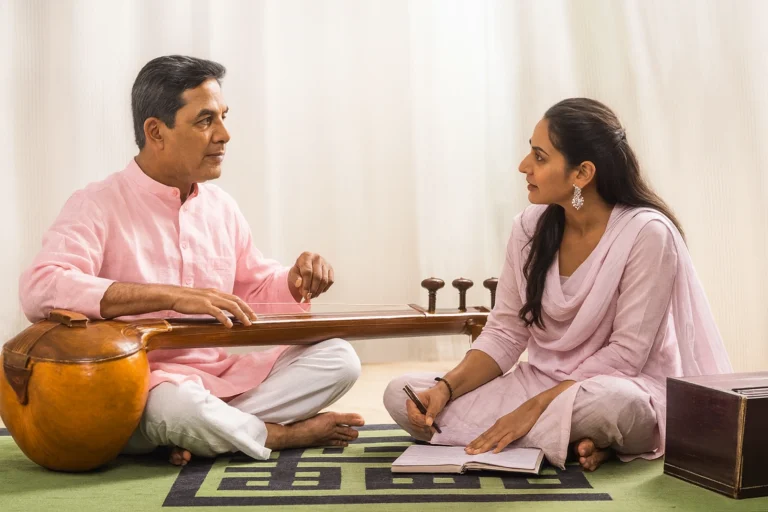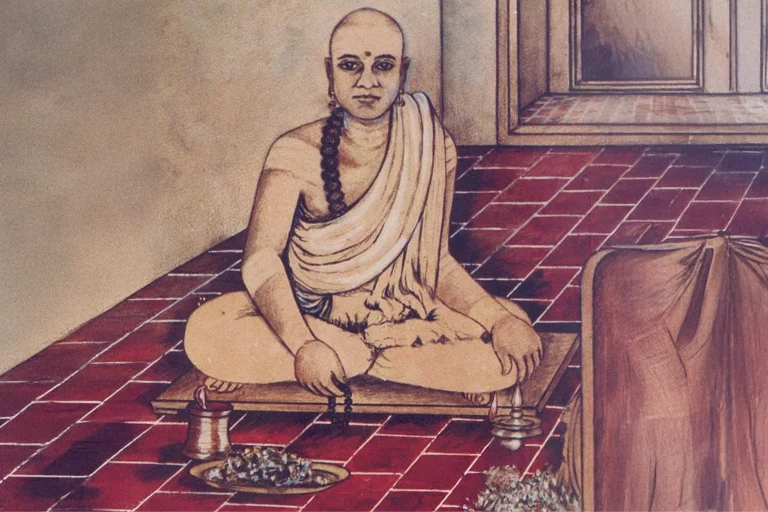All Topics
- Alchemizing Music Concepts for Students
- Artist Spotlight
- artium gift card
- Artium Maestros
- Artium News
- buying guide
- Carnatic Music
- Devotional Music
- Editorials by Ananth Vaidyanathan
- Film Music
- Guitar
- Hindustani Classical Music
- Indian Classical Music
- Indian Folk Music
- Insights
- Instruments
- Karaoke Singing
- Keyboard
- Kids Music
- maestros
- Music Education
- Music for Kids
- Music Industry
- Music Instruments
- Music Legends
- Music Theory
- Music Therapy
- Piano
- piano guide
- Success Stories
- Tamil Film Music
- Telugu Film Music
- Time Theory
- Tools
- Uncategorized
- Vocal Singing
- Vocals
- western classical music
- western music
- Western vocal music
How Does Alankaram In Carnatic Music Shape a Musician’s Sense of Tala and Laya?
How Does Alankaram In Carnatic Music Shape a Musician’s Sense of Tala and Laya?

Table of Contents
In Carnatic music, every note and rhythm flows within a precise yet creative framework of Sruti (pitch), Tala (time cycle), and Laya (tempo). Among the foundational exercises that build a student’s understanding of these concepts, Alankaram (also spelled Alankara) plays a pivotal role.
Derived from the Sanskrit word “Alankara,” meaning ornamentation, Alankarams in Carnatic music are not just rhythmic sequences. They are musical patterns that decorate learning with beauty, logic, and discipline. They are practiced systematically in different talas (rhythmic cycles) to develop rhythmic awareness, precision, and an intuitive grasp of Laya, the rhythmic flow of music.
In today’s digital era, online Carnatic music classes have made learning these intricate rhythmic patterns accessible to students worldwide. Through structured lessons, guided practice, and interactive feedback, learners can now perfect their Alankaram exercises from the comfort of their homes while maintaining the authenticity of traditional training.
This blog explores how Alankaram in Carnatic music shapes a musician’s Tala and Laya sensibility, details the seven basic Alankarams taught in Carnatic training, and explains why they remain timeless stepping stones in a musician’s journey in traditional and online learning environments.
What is Alankaram in Carnatic Music?
Alankaram in Carnatic music refers to structured exercises that combine swara (notes) with tala (rhythm) to create melodic and rhythmic patterns. The term literally means “ornamentation,” and these exercises serve as a bridge between basic note practice and more complex compositions. Alankaras are usually set to simple Geetams or Sarali Varisais and progress through various rhythmic cycles, helping students internalize Tala and Laya, the rhythm and tempo essential to Carnatic music performance.
The importance of Alankaram lies in its ability to develop technical precision, voice control, and rhythmic understanding. By practicing these exercises regularly, learners gain fluency in executing swaras accurately while maintaining proper timing.
They also build a strong foundation for improvisation, raga elaboration, and tackling complex compositions later in their musical journey. Essentially, Alankaras are the training ground where a Carnatic musician hones discipline, creativity, and a deep connection to rhythm, making them indispensable in learning Carnatic vocal music.
What is the Purpose of Alankaram Practice?
The Alankaram exercises come after a student learns the Sarali Varisai and Janta Varisai in the Raga Mayamalavagowla, the traditional beginner’s raga. While Sarali and Janta focus on pitch accuracy and smooth transitions between notes, Alankarams connect melody to Tala, integrating Swaras (notes) with rhythmic structures.
Practicing Alankarams helps a student:
- Synchronize hand movements and voice within complex rhythmic cycles.
- Internalize beat divisions (nadai) such as chatusra (4), tisra (3), khanda (5), misra (7), and sankeerna (9).
- Develop a natural ability to anticipate and resolve rhythmic phrases within the Avartanam (cycle of tala).
- Strengthen Laya Gnanam — rhythmic intelligence that allows a musician to maintain perfect timing even during improvisation.
As Purandara Dasa, the Father of Carnatic Music, envisioned, Alankarams are not just drills — they are the rhythmic foundation of creativity.
Understanding Tala and Laya Through Alankarams
Tala is the rhythmic framework that defines time in music. It is measured in cycles (avartanams) consisting of beats (aksharas). Each tala has different components, such as laghu (beat count depending on jati), dhrutam (a beat and a wave), and anudhrutam (a single beat).
Watch and learn to sing Alankarams in Carnatic music-
Laya, on the other hand, refers to tempo, the speed at which music is performed. There are three main speeds (kalams):
- Vilambita Laya – Slow Tempo: A leisurely pace that allows deep expression and careful exploration of rhythm.
- Madhyama Laya – Medium Tempo: A balanced, moderate speed ideal for steady performance and learning rhythmic patterns.
- Druta Laya – Fast Tempo: A rapid pace that tests agility, precision, and mastery over rhythm and timing.
When a student practices Alankaram lessons at multiple speeds across different talas, they subconsciously learn the mathematics of rhythm —the subdivision of beats —and the sense of proportion between melody and tempo. This rhythmic precision is what differentiates a trained Carnatic musician from an untrained singer.
The Seven Basic Alankarams in Carnatic Music
Traditionally, Alankaram in Carnatic music is taught in the raga Mayamalavagowla, composed in the 35 fundamental talas, of which seven are considered essential for beginners. Each Alankaram follows the same melodic sequence (S R G M P D N S – S N D P M G R S), but the rhythmic structure varies based on the tala.
Let’s explore these seven Alankarams in Carnatic music:
1. Chatusra Jaati Dhruva Tala Alankaram
Structure: I4 0 I4 I4 = 4 + 2 + 4 + 4 = 14 beats
This Alankaram introduces students to one of the most complex talas, with a longer cycle. It demands precise counting and coordination between hand gestures and swara patterns. Practicing this enhances patience, timing accuracy, and concentration, crucial for handling long rhythmic cycles in advanced compositions like Ragam-Tanam-Pallavi.
2. Chatusra Jaati Matya Tala Alankaram
Structure: I4 0 I4 = 4 + 2 + 4 = 10 beats
The Matya Tala balances medium complexity with fluid rhythm. It trains students to identify mid-length cycles and maintain symmetry between ascent (Arohana) and descent (Avarohana). It also cultivates a smooth transition from one Avartanam to the next, helping students internalize cyclical rhythm.
3. Chatusra Jaati Rupaka Tala Alankaram
Structure: 0 I4 = 2 + 4 = 6 beats
This tala is widely used in Kritis and Varnams. Its relatively shorter cycle helps students understand rhythmic phrasing and resolve musical ideas neatly within a 6-beat structure. Through this, musicians begin to sense how melodies can breathe naturally within rhythm.
4. Mishra Jaati Jhampa Tala Alankaram
Structure: I7 U 0 = 7 + 1 + 2 = 10 beats
This tala introduces asymmetry, the beauty of uneven rhythmic divisions. The “U” (anudhrutam) and “0” (dhrutam) require alertness, teaching students adaptability to complex nadai patterns. Mishra Jhampa Tala enhances a musician’s flexibility and prepares them for advanced rhythmic explorations such as Tisram and Khanda Nadai.
Learn to sing Jhampa Talam Alankaram:
5. Thrisra Jaati Triputa Tala Alankaram
Structure: I3 0 0 = 3 + 2 + 2 = 7 beats
This 7-beat cycle in Carnatic classical music (often referred to as Misra Chapu in practice) fosters the ability to group beats in threes, which is essential for compositions set in Tisra nadai. Practicing this Alankaram develops a dancer-like rhythmic agility, enabling a natural flow between melody and rhythm.
6. Khanda Jaati Ata Tala Alankaram
Structure: I5 I5 0 0 = 5 + 5 + 2 + 2 = 14 beats
This is one of the most mathematically rich talas. The uneven beat divisions require sharp mental focus and control. Mastering this Alankaram strengthens a student’s inner metronome and equips them to handle complex Khanda Chapu compositions found in later Carnatic repertoire.
7. Chatusra Jaati Eka Tala Alankaram
Structure: I4 = 4 beats
This 4-beat cycle is fundamental yet straightforward. It’s the perfect tool for practicing multiple speeds (kalams) — one note per beat, two notes per beat, and so on. By gradually increasing speed, students learn the delicate balance between tempo control and clarity, shaping their understanding of Laya.
Building Laya Gnanam
Alankaram in Carnatic music is more than mechanical exercises; it cultivates Laya Gnanam, the intuitive rhythmic intelligence that defines great performers. Through repetition, a student learns to “feel” tala rather than merely count it.
Easy techniques to sing Alankars in Carnatic music-
Here’s how Alankaram practice develops this inner rhythm:
- Rhythmic Accuracy: Each tala structure reinforces the mathematical precision required to fit swaras within beats.
- Multi-Speed Dexterity: Singing or playing Alankarams in Carnatic music at three or more speeds enhances control and consistency.
- Internal Pulse: The student begins to “internalize” beats —a skill essential for improvisational segments such as Kalpana Swaras and Neraval.
- Tala Visualization: Repetitive practice synchronizes vocal patterns with hand gestures, allowing musicians to visualize rhythm as a geometric flow.
As one of the music teachers famously said, “If you master your Alankarams, Tala will never betray you.”
The Bridge to Creativity and Manodharma
In Carnatic music, Manodharma Sangeetham, the creative, improvised dimension, blossoms only when a musician is rhythmically grounded. Alankarams serve as that bridge between structure and freedom.
When artists improvise swaras in concerts, their spontaneous creativity still adheres to the tala structure — thanks to years of Alankaram practice. Even during Tani Avartanam (the percussion solo), vocalists and instrumentalists who have internalized tala through Alankaram in Carnatic music can follow complex rhythmic cycles seamlessly.
This rhythmic awareness also translates beautifully into dance, instrumental music, and even composing, making Alankaram the universal foundation of Carnatic rhythm.
From Discipline to Artistry
Alankarams teaches a crucial artistic principle that says ‘discipline breeds freedom.’ The exercises might seem repetitive at first, but within their patterns lies the secret to expressive music. When mastered, they free a musician from conscious counting, allowing emotion and spontaneity to take over.
Through Alankaram in Carnatic music practice, students not only strengthen their technical control but also experience music as mathematics in motion, a perfect union of science and soul.
Alankarams are much more than the early lessons of Carnatic vocal music online; they will be introduced in the intermediate and advanced levels of the music course. They are rhythmic meditations that sculpt a musician’s timing, balance, and creative fluency. By internalizing tala cycles and nurturing Laya Gnanam, they prepare students for every rhythmic challenge Carnatic music presents, from simple geetams to intricate ragam-tanam-pallavis.
At Artium Academy, we believe that learning Carnatic classical music should be both immersive and transformative. As Purandara Dasa’s timeless pedagogy reminds us, mastering the basics of rhythm is the first step toward transcendence in music. Online Carnatic music classes with Artium focus on developing a deep sense of tala and laya, ensuring that students not only count beats but feel and flow with rhythm.
Whether you want to learn Carnatic online or refine your vocal skills, Artium Academy’s personalized guidance helps every student progress with confidence. Book a free trial class today and take your first step into the enriching world of Indian classical music. Your journey toward musical mastery begins here.
FAQs on Alankaram In Carnatic Music
In Carnatic music, there are seven primary alankaras. These are foundational melodic and rhythmic exercises designed to train students in swara patterns, tala (rhythm), and voice control. Practicing these alankaras develops precision, fluency, and improvisational skills, forming a vital part of early Carnatic training.
In Carnatic music, Alankaram are exercises that combine swara (notes) with tala (rhythm) to create melodic and rhythmic patterns. Meaning “ornamentation,” they bridge basic note practice and complex compositions. Alankaras in Carnatic music develops precision, voice control, and rhythmic understanding, helping students internalize Tala and Laya. Regular practice builds fluency, timing, and a foundation for improvisation and raga elaboration. They are essential for nurturing discipline, creativity, and a deep connection to rhythm, forming a cornerstone of Carnatic music training.
Alankarams differ from Sarali and Janta Varisai in purpose and complexity. While Sarali Varisai are simple ascending-descending exercises and Janta Varisai focus on paired swaras, Alankarams combine swaras with rhythm (tala) in structured patterns, often set to specific compositions. They train timing, voice control, and improvisation, going beyond basic swara practice. Essentially, Sarali and Janta build the foundation, whereas Alankarams refine musicality, rhythm, and creativity, preparing students for more advanced Carnatic compositions and performances.
The seven basic Alankarams in Carnatic music are structured exercises set to the seven fundamental talas to develop swara precision and rhythmic understanding. They are: Tisra Alankaram, Chatusra Alankaram, Khanda Alankaram, Misra Alankaram, Sankeerna Alankaram, Ata Alankaram, and Triputa Alankaram. Practicing these helps students internalize Tala and Laya, build voice control, and develop fluency in executing swaras across different rhythmic cycles. Together, they form a core foundation for advanced Carnatic learning and improvisation.
Practicing Alankaram enhances a musician’s creativity by training the mind and voice to explore swaras within rhythmic frameworks. As students practice different patterns, tempos, and talas, they develop flexibility and improvisational skills, learning to experiment with variations while maintaining rhythm. This deepens their understanding of raga nuances and encourages inventive phrasing. Alankaram transforms structured exercises into a creative toolkit, enabling musicians to craft expressive interpretations, innovate within compositions, and confidently improvise during performances.
Yes, you can learn Alankarams through online Carnatic music classes in the advanced and proficient levels of learning music. Virtual lessons offer personalized guidance, structured practice, and real-time feedback on swaras, rhythm, and tala. With online platforms, students can access recorded exercises, interactive sessions, and expert instructors, making it easy to practice at their own pace. Online music classes ensure that the fundamentals of Alankaram; precision, timing, and voice control, are effectively taught, helping learners build a strong foundation and progress confidently in Carnatic music.








